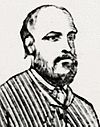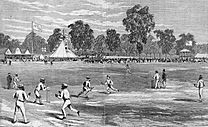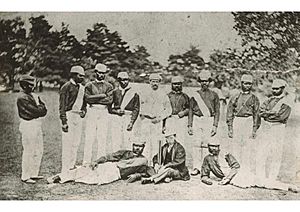Australian Aboriginal cricket team in England in 1868 facts for kids
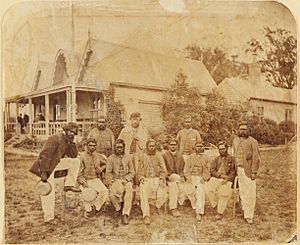
In 1868, a cricket team made up of Aboriginal Australians travelled to England. They toured from May to October that year. This made them the first organised group of Australian sportspeople to ever travel overseas. It would be another ten years before an Australian cricket team officially representing the country would leave Australia.
The idea for an Aboriginal cricket team started on farms in the Western District of Victoria. In the mid-1860s, European farmers taught Aboriginal farm workers how to play cricket. An Aboriginal team was formed with help from Tom Wills. He was the captain of the Victoria cricket team and started Australian rules football. Wills coached and captained the team before and during a tour of Victoria and New South Wales in 1866–67. Several players from this team joined the Aboriginal team that toured England. This team was captained by an Englishman named Charles Lawrence.
Back then, it was very unusual for sports teams to travel to other countries. Before this, only three cricket teams had travelled abroad. All of them were English teams. They went to the United States and Canada in 1859. They also visited Australia in 1861–62 and 1863–64.
Contents
How the Team Started
From the early 1860s, cricket games were played on farms in the Western District of Victoria. These games were between Aboriginal people and European settlers. Many Aboriginal people worked as farm workers for local farm owners. People admired the Aboriginal players for their athletic skills. In early 1866, several games were played to choose the best Aboriginal team. Thomas Gibson Hamilton, from Bringalbert Station, near Edenhope, created a team and coached them. They played a special game in Hamilton. This game caught the attention of Tom Wills.
The team was first coached by a local farmer, William Hayman. Later, Tom Wills took over the coaching. Wills was the captain of the Victoria cricket team and founded Australian rules football. He spoke to the team in an Aboriginal language he learned as a child. He grew up in the Western District among the Djab Wurrung people. Wills' decision to help the team was interesting. Only five years earlier, he survived a tragic event in Queensland. His father and 18 other settlers were killed by local Aboriginal people. One sportswriter said, "It was always a matter of wonder how Tom could be friendly with the blacks, considering that they murdered his father."
On Boxing Day 1866, over 10,000 people watched Wills captain the team. They played against the Melbourne Cricket Club at the Melbourne Cricket Ground. Bell's Life in Victoria reported that "Seldom has a match created more excitement in Melbourne." The Sydney Mail wrote that "A dark skin suddenly became a passport to the good graces of Victorians." Even though they lost to the MCC, the Aboriginal players were praised for how well they played. They showed great improvement on a later tour of country Victoria.
An organiser named Captain Gurnett convinced the team to travel to Sydney. He planned a tour of Australia and England. But after they arrived in Sydney in February 1867, Gurnett stole some of the money meant for the tour. This left the team stranded. Charles Lawrence looked after the team at his Manly Hotel. He arranged several games to complete a tour of New South Wales. The team returned to Victoria in May. Sadly, four players became very ill. Sugar and Watty died during the tour. Jellico and Paddy died soon after.
Meet the Team
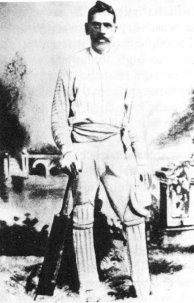
In 1867, Charles Lawrence was hired to be the captain and coach of Australia's 'First Eleven' team. This team toured England in 1868. Lawrence had played cricket for Surrey, the all Ireland XI, and the all England XI. He was the first professional cricket coach in New South Wales. He first saw the Aboriginal team when they played a match at the Albert Ground, Sydney. This was when there was a problem with the sponsor Gurnett and Tom Wills. The players were left in Sydney. Lawrence was asked to take care of the Aboriginal players. At that time, Lawrence owned a hotel. He let the players stay there until he could arrange some cricket matches to raise money to send them back to Victoria. In 1867, he trained the players for two months at "Lake Wallace" in Edenhope. Then he chose the team to tour England in 1868.
A Sydney lawyer named George Graham, his cousin George Smith, and William Hayman paid for the tour. They all travelled to England with the team.
- Charles Lawrence – Captain / Coach
- Johnny Mullagh – traditional name: Unaarrimin
- Bullocky – traditional name: Bullchanach. He was a wicketkeeper. People called him "the black Bannerman and Blackham of his team".
- Sundown – traditional name: Ballrin
- Dick-a-Dick – traditional name: Jungunjinanuke
- Johnny Cuzens – traditional name: Zellanach
- King Cole – traditional name: Bripumyarrimin
- Red Cap – traditional name: Brimbunyah
- Twopenny – traditional name: Murrumgunarriman
- Charley Dumas – traditional name: Pripumuarraman
- Jimmy Mosquito – traditional name: Grougarrong. He was known for being able to "walk upright under a bar and then jump it in a stander".
- Tiger – traditional name: Boninbarngeet
- Peter – traditional name: Arrahmunijarrimun
- Jim Crow – traditional name: Jallachniurrimin
In June, King Cole died from a serious illness and was buried in London. Sundown and Jim Crow went home in August because they were unwell.
The Tour of England
The team arrived in London on May 13, 1868. People were very curious about them. This was a time when Charles Darwin's book The Origin of Species had just been published. People had mixed reactions. The Times newspaper called the team "a travestie upon cricketing at Lord's". They also called them "the conquered natives of a convict colony." The Daily Telegraph said that "nothing of interest comes from there except gold nuggets and black cricketers."
The first match was played at The Oval in London on May 25. About 20,000 people came to watch. Many of these people probably came out of curiosity, not just to see a cricket game. The Times reported:
"Their hair and beards are long and wiry, their skins vary in shades of blackness, and most of them have broadly expanded nostrils. Having been brought up in the bush to agricultural pursuits under European settlers, they are perfectly civilised and are quite familiar with the English language."
The Daily Telegraph wrote:
It is highly interesting and curious, to see mixed in a friendly game on the most historically Saxon part of our island, representatives of two races so far removed from each other as the modern Englishman and the Aboriginal Australian. Although several of them are native bushmen, and all are as black as night, these Indian fellows are to all intents and purposes, clothed and in their right minds.
Overall, the Aboriginal team played 47 matches across England over six months. They won 14 games, lost 14, and drew 19. This was a good result that surprised many people at the time. Some players were amazing athletes, while two or three others did not contribute much. The best player was Johnny Mullagh. He scored 1,698 runs and took 245 wickets. A famous English fast bowler, George Tarrant, bowled to Mullagh during a break. He later said, "I have never bowled to a better batsman."
Besides playing cricket, the Aboriginal players often showed off their skills. They would throw boomerangs and spears after a match. Dick-a-Dick would also hold a narrow shield and let people throw cricket balls at him. He would block the balls with his shield. The Aboriginal team was almost beaten in a cricket-ball-throwing contest. A rising English star, 20-year-old W. G. Grace, threw the ball 118 yards.
What Happened Next
The team returned to Sydney in February 1869. They played a match against a military team the next month, then they split up. Twopenny later moved to New South Wales. He played for the colony against Victoria in 1870. Johnny Cuzens died from an illness the next year. Johnny Mullagh worked as a professional player for the Melbourne Cricket Club. He played for Victoria against the English team in 1879. He scored the most runs in the second part of that game.
In 1869, the Central Board for Aborigines made a rule. It said that it would be illegal to take any Aboriginal person out of Victoria without government approval. This rule stopped Aboriginal players from being involved in cricket.
When Mullagh died at age 50 in August 1891, people thought he was the last survivor of the team (apart from Lawrence, who died in 1917). However, it is now believed that Red Cap died between 1891 and 1894. Tarpot died in April 1900.
Their Lasting Impact
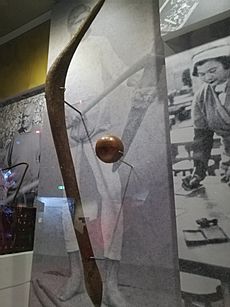
In May 1988, a team of Aboriginal players, led by John McGuire, toured England. This tour marked the Australian Bicentenary and followed the path of the original tour.
- 2002 – The Australian Sports Hall of Fame recognised the 1868 Indigenous touring team. They were honoured for their important contribution to sport.
- 2004 – Cricket Australia gave cap numbers to the 1868 team members.
- 2004 – The Johnny Mullagh interpretative centre opened in Harrow.
- 2018 – Australia Post released a stamp celebrating 150 years since the 1868 tour.
- 2018 – Cricket Australia held a smoking ceremony at Johnny Mullagh's sacred water hole in Harrow. This celebrated 150 years since the tour.
In 2002, Charles Lawrence's great-great-grandson Ian Friend, historians, and cricketers, including former Test captain Ian Chappell, worked together. They successfully campaigned to have the Aboriginal team recognised in the Sport Australia Hall of Fame. Ian Friend and Jack Kennedy (a descendant of Johnny Cuzens) accepted the award for the team. Also that year, a documentary film about the team, called A Fine Body of Gentlemen, was shown by the ABC.
Australia sent men's and women's Aboriginal teams to England in June 2018. This was to mark the 150th anniversary of the historic tour.
A play about the cricketers, called Black Cockatoo, was written by Geoffrey Atherden. It had an all-Aboriginal cast and was performed at the 2020 Sydney Festival.
In January 2020, Len Pascoe encouraged singer/songwriter Matt Scullion to write a song about the tour. Scullion wrote the song, called "1868". He sang it at a cricket match in Sydney in early 2021. He plans to sing it again at the Bradman Museum in April 2021.


